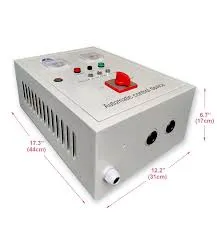1. Common sewage pit sewage float control
The system can use one or more water pumps. When one water pump is used, the float switch floats up and down with the liquid level in the sump. When the float is at the pump-on water level, the float starts the submersible sewage pump through the control cabinet to start drainage; When the float is at the pump stop level, the float stops the operation of the submersible sewage pump through the control cabinet. When multiple water pumps are used, when the main pump fails, the standby pump is automatically put into operation, and the control cabinet simultaneously displays the submersible sewage pump failure signal.
The standby pump of the liquid level is put into operation; the main pump works when the sewage flows into the sump with a small flow, and the standby pump is also put into operation when the liquid level rises to another float switch due to the large flow or the main pump failure.
2. Sewage control of drainage pumping station
Manual replacement/failure switching: arbitrarily select the main pump and the standby pump. The main pump works when the water level is high. When the main pump fails or the control circuit fails, the standby pump is put into operation after a delay and alarms with sound and light. When it flows into the sump The sewage flow is greater than the main pump displacement, and when the water level rises to an ultra-high water level, the standby pump is put into operation after a delay and an audible and visual alarm is given.
Single Phase Start Control Box
3. Sewage control of drainage pumping station
Automatic alternate rotation: When the water level reaches the high water level, the 1# (or 2# pump) runs to complete the drainage first, when the water level reaches the high water level for the second time, it will turn to 2# (or 1# pump) to complete the drainage main, The standby pumps work alternately, and when the water level reaches the ultra-high water level, both pumps are put into operation.
4. The bigger feature of the sewage pump station is that the displacement of the sewage pump changes greatly. The submersible sewage pump is selected according to the characteristics of the flow change. Each pump is controlled by the control cabinet to start and stop according to the water level in the sump. When the displacement is small, the small pump (or Only start one pump). When the displacement is large, start the large pump (or start multiple pumps) to achieve more complex control functions through the intelligent control of the control cabinet microcomputer.
5. The liquid level float switch relies on the flip of the float to drive the internal slider to output the start and stop pump signals. This is a mechanical action, and its durability and control accuracy are limited by the float. In some liquid control occasions that require high precision, such as narrow elevator shafts, small deep well pump pits, etc., floating balls are not suitable.
6. Special level control
Equipped with a special water level controller with three-pole rod sensing electrodes that rely on water to conduct electrical signals, it can be suitable for automatic water level control in any occasion, and the control accuracy can reach within 1mm. In some occasions, due to some special reasons, the controlled medium should not have a built-in liquid level sensor or have higher requirements on the liquid level sensor.

